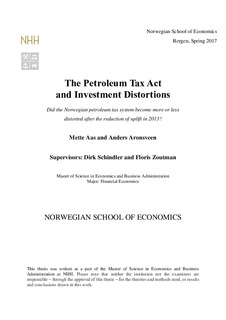| dc.description.abstract | In light of Sandmo’s (1989) definition of neutrality, the objective of the thesis is to measure
investment distortions in the Petroleum Tax Act (PTA) before and after the reduction of
investment uplift in May 2013. The study relies on one unified model and applies two different
approaches, where the model is based on the research conducted by Lund (1987, 1992).
Neutrality is analysed from a governmental point of view with a contingent claims analysis
(CCA). This method is consistent with the neutrality properties of Boadway and Bruce (1984)
and Fane (1987). Thereafter, neutrality is evaluated from a petroleum industrial perspective
applying a discounted cash flow (DCF) method. The effect of the reduced uplift is analysed for
a firm outside tax position and a company in tax position. Investment distortions are illustrated
by comparing the neutrality properties of the PTA, against the neutral Brown cash flow tax and
the Norwegian General Tax Act.
The results show that if companies apply a CCA, they have incentives to overinvest. After the
reduction of uplift, the incentives to overinvest have been reduced, and tax revenue has
increased. In contradiction, if firms outside tax position use a DCF method the PTA gives
incentives to underinvest, and the effect on tax income is uncertain. For a company in tax
position, the DCF results show that the PTA is relatively neutral and tax income has increased
after the reduction of uplift. This implies it is an advantage to be in tax position, creating barriers
to entry from an industrial perspective. Based on these results, we find it likely that the PTA
has become more neutral and tax income increased after the reduction of uplift. | nb_NO |
